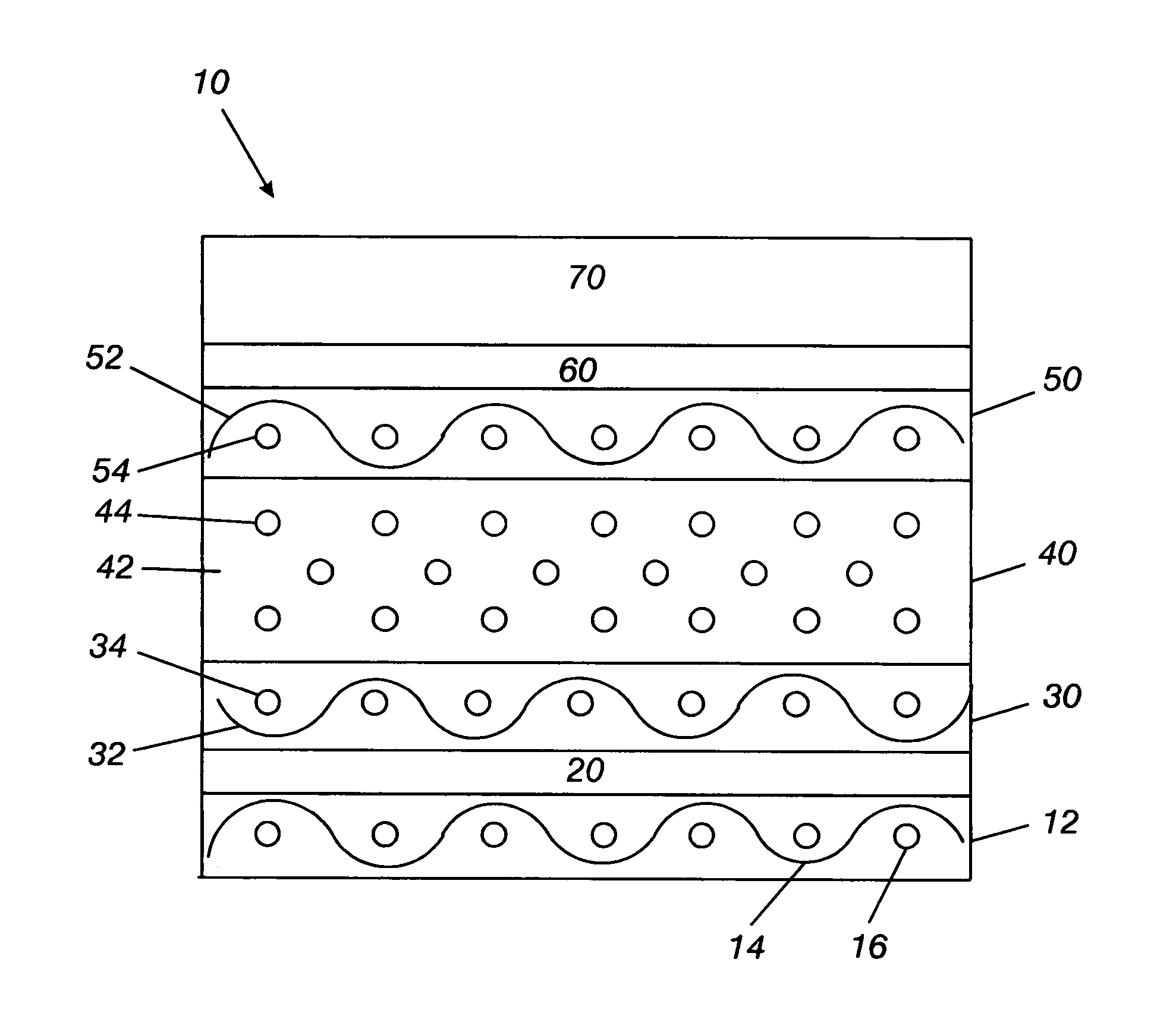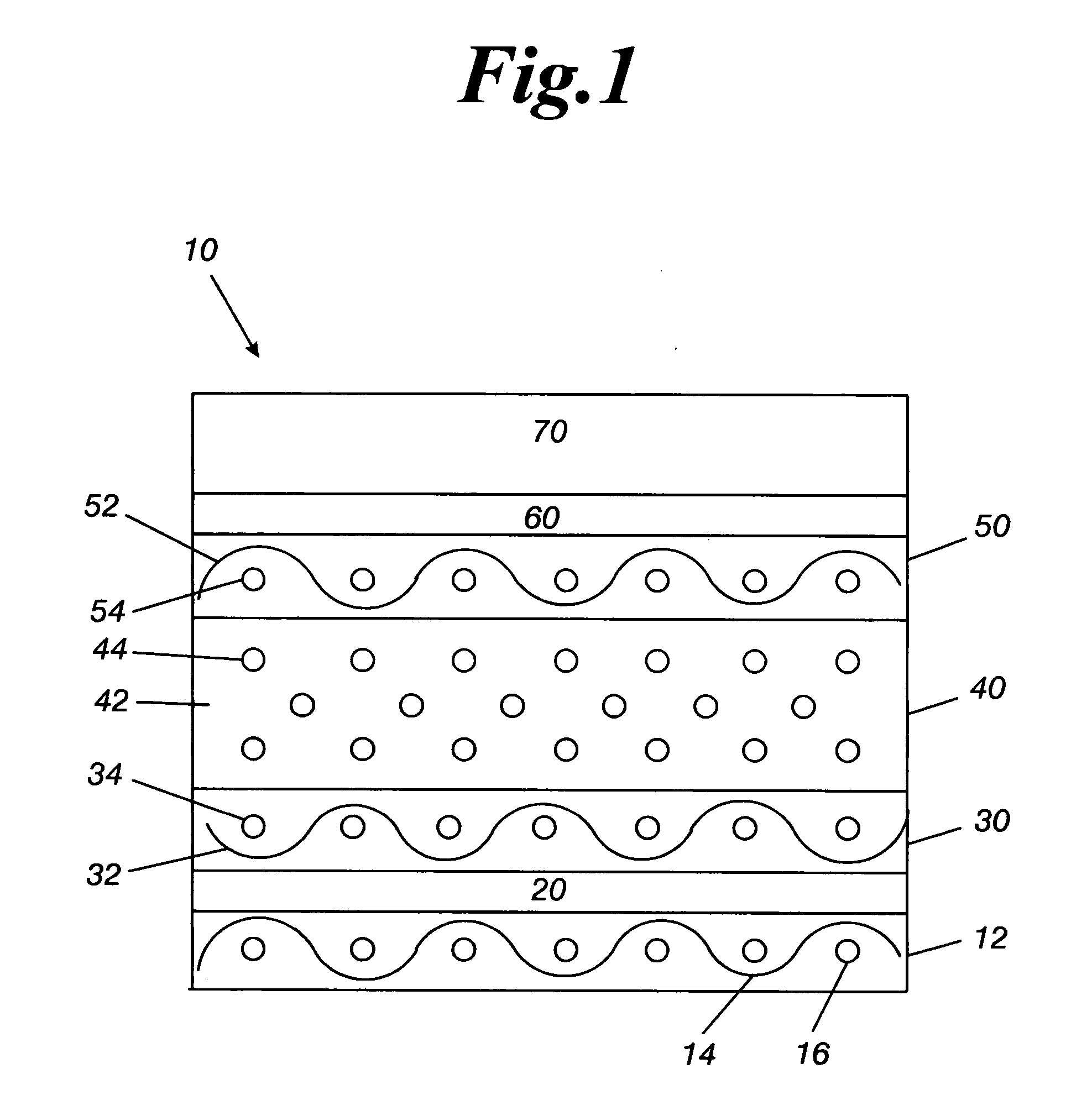Thermoset printing blanket
- Summary
- Abstract
- Description
- Claims
- Application Information
AI Technical Summary
Benefits of technology
Problems solved by technology
Method used
Image
Examples
example 1
[0052] The adhesive was conditioned in an oven at 85° C. for 2 hours prior to coating. The samples were prepared by coating S / 4195 (base-ply) with the shown sample at 0.010 inch K / R gap setting. S / 4200 (middle-ply) was then nipped / laminated to the coated base-ply. The samples were allowed to cure for 24 hours.
[0053] The polyurethane composition was heated at 120° C. for two hours. The carcass middle layer was then coated with the shown PU composition at 0.035 inch K / R gap setting. Top layer S / 4232 was then laminated into the hot adhesive. The sample was allowed to cure for 72 hours.
[0054] The following PUs were supplied:
Viscosity (cps)% MicrospheresComposition #@ 100° C.(by weight)A (SG 15 16-31)294002.0B (SG 15 16-32)436002.5C (SG 15 16-33)342003.0D (SGH 0005-3A)SGH0005-3A
[0055] Viscosity was measured with a Brookfield TT-100 inline viscometer. Gauge was measured with a Cady deadweight bench micrometer, or Cady Gauge. E130-095AD microspheres manufactured by Dualite were utilize...
example 2
[0056] The adhesive was conditioned in an oven at 120° C. for 2 hours prior to coating.
[0057] The samples were prepared by coating S / 4195 (base-ply) with the shown sample at 0.010 inch K / R gap setting. S / 4200 (middle-ply) was then nipped / laminated to the coated base-ply. The samples were allowed to cure for 24 hours.
[0058] The polyurethane composition was heated at 120° C. for two hours. The carcass middle layer was then coated with the shown PU composition at 0.045 inch K / R gap setting. Top layer S / 4232 was then laminated into the hot adhesive. The sample was allowed to cure for 96 hours.
[0059] The compressible layer PU contained Dualite E130-095AD microspheres.
[0060] The following PUs were supplied:
Viscosity (cps)% MicrospheresComposition #@ 100° C.Open-time (sec.)(by weight)A (SG 1516-137)12200240B (SG 1516-138)11270550C (SG 1516-144)23950600D (SG 1516-148)65000106E (SG 1516-149)62800306
[0061] Viscosity was measured with a Brookfield TT-100 inline viscometer. Gauge was meas...
example 3
[0063] The adhesive was conditioned in an oven at 120° C. for 2 hours prior to coating. The samples were prepared by coating S / 4195 (base-ply) with the shown sample at 0.010 inch K / R gap setting. S / 4200 (middle-ply) was then nipped / laminated to the coated base-ply. The samples were allowed to cure for 24 hours.
[0064] The polyurethane composition was heated at 120° C. for two hours. The carcass middle layer was then coated with the shown PU composition at 0.045 inch K / R gap setting. Top layer S / 4232 was then laminated into the hot adhesive. The sample was allowed to cure for 96 hours.
[0065] The following PUs were supplied:
Viscosity (cps)% MicrospheresComposition #@ 100° C.Open-time (sec.)(by weight)A (SG 1516-148)65000106B (SG 1516-149)62800306
[0066] Viscosity was measured with a Brookfield TT-100 inline viscometer. Gauge was measured with a Cady deadweight bench micrometer, or Cady Gauge. E130-095AD microspheres manufactured by Dualite were utilized in the compressible polyureth...
PUM
 Login to view more
Login to view more Abstract
Description
Claims
Application Information
 Login to view more
Login to view more - R&D Engineer
- R&D Manager
- IP Professional
- Industry Leading Data Capabilities
- Powerful AI technology
- Patent DNA Extraction
Browse by: Latest US Patents, China's latest patents, Technical Efficacy Thesaurus, Application Domain, Technology Topic.
© 2024 PatSnap. All rights reserved.Legal|Privacy policy|Modern Slavery Act Transparency Statement|Sitemap


